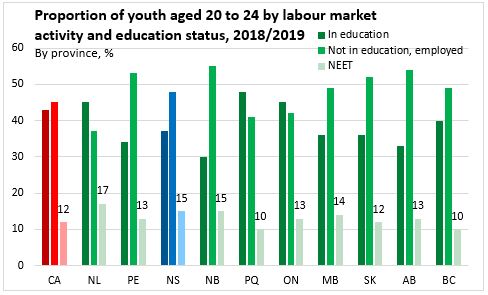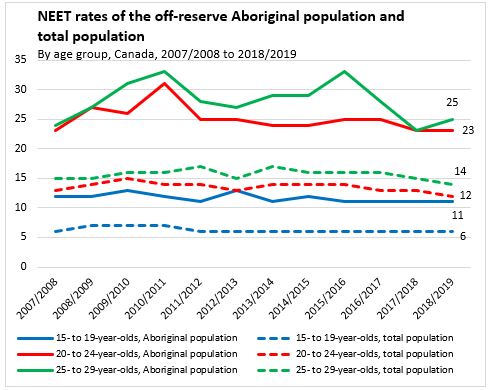The Economics and Statistics Division maintains archives of previous publications for accountability purposes, but makes no updates to keep these documents current with the latest data revisions from Statistics Canada. As a result, information in older documents may not be accurate. Please exercise caution when referring to older documents. For the latest information and historical data, please contact the individual listed to the right.
<--- Return to Archive
For additional information relating to this article, please contact:
July 05, 2019STUDY: THE TRANSITION FROM SCHOOL TO WORK: THE NEET (NOT IN EMPLOYMENT, EDUCATION OR TRAINING) INDICATOR FOR 20- TO 24-YEAR-OLDS IN CANADA Statistics Canada has released the third study in their series exploring youth NEET (not in employment, education or training) rates in Canada. This study focuses on the age group 20 to 24 years, when young people are likely to have started their transition from school to the labour market. The study draws comparisons across the provinces, as well as examines the effect of education levels, immigrant status, having a disability, residing in a rural area or population centre, Aboriginal identity, and of having children in the household. Data come from the Labour Force Survey.
In 2018/2019 (September 2018 - April 2019), 45 per cent of youth aged 20 to 24 were employed and 43 per cent were still in school. Women were more likely than men to be in school, while men were more likely to be working. The NEET rate for this age group was 12 per cent in 2018/2019 and has ranged between 12 and 15 per cent over the last twenty years, reaching its lowest level in 2018/2019. In that year, 60 per cent of NEETs were inactive (not looking for a job) and 40% were unemployed.
Over the past 20 years, the Canadian NEET rate for those aged 20 to 24 was between one and five percentage points lower than the OECD average. This was due to Canadian women who have a NEET rate lower than the OECD average, while NEET rates for Canadian men are similar to the OECD average.
Across the country, NEET rates were highest in Newfoundland and Labrador (17 per cent) and Nova Scotia and New Brunswick (both 15 per cent) and lowest in Quebec and British Columbia (both 10 per cent). Except for Newfoundland and Labrador, no province had a NEET rate that was significantly different than the national average of 12 per cent.

The NEET rates of men and women aged 20 to 24 were similar with no significant differences between genders in any province. However, female NEETs were 2.5 times more likely to be inactive than unemployed, while male NEETs were twice as likely to be unemployed than female NEETs. The gender differences between NEET rates is more pronounced for those aged 25 to 29, an age where motherhood is more prevalent. Women with children who are NEET are more likely to be inactive than unemployed.
Young people aged 20 to 24 without a high school diploma are at a higher risk of being NEET. In 2018/2019, 37 per cent of youth aged 20 to 24 without a high school diploma were in NEET. This rate has varied from 31 per cent to 39 per cent over the last 20 years. The proportion was higher for women (47 per cent) than men (30 per cent) in 2018/2019. The vast majority of NEETs without a high school diploma were inactive (not looking for a job). Of the inactive NEET youth aged 20 to 24, 12 per cent reported being permanently unable to work. This proportion is higher (18 per cent) among those without a high school diploma.
Similar to those aged 25 to 29, close to seventy per cent of NEET youth aged 20 to 24 did not want a job. There was less of a difference between men and women (64 and 73 per cent not wanting a job, respectively) among 20 to 24 year olds compared to those aged 25 to 29 (56 to 81 per cent) which may be related to the prevalence of motherhood in the older age group. More than half of NEETs aged 20 to 24 reported working or being in school as their main activity in the 12 months prior to being surveyed, which indicates being NEET may be temporary.
Immigrants aged 20 to 24 had similar NEET rates to the non-immigrant population. Young immigrants were more likely to be in school and less likely to be working compared to the non-immigrant population.
Aboriginal youth had significantly higher unemployed and inactive NEET rates compared to the overall population. The higher NEET rates reflect both lower rates of youth education (for those aged 15 to 19 and 20 to 24) and lower employment (for those aged 25 to 29). Among off-reserve Aboriginal youth aged 20 to 24, 23 per cent reported being NEET in 2018/2019 compared to 12 per cent for the overall population. NEET rates for Aboriginal youth aged 20 to 24 have varied between 23 and 31 per cent, peaking after the 2008/2009 recession.

There were no significant differences in NEET rates of those aged 20 to 24 for those living in rural areas or population centres, with the exception of those in Manitoba. Youth in rural areas were more likely to be working, while those in population centres were more likely to be in school.
Youth aged 20 to 24 who reported being NEET in 2018/2019 were more likely to report also having a partner who was NEET compared to those who were in education or in employment. This may lead to a precarious income situation for households in which there are no employed adults.
Source: Statistics Canada
Daily Release | Full Report
<--- Return to Archive